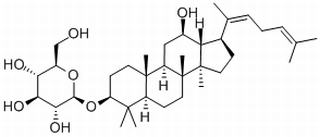Home
Products
Ginsenoside Rh3



| Product Name | Ginsenoside Rh3 |
| Price: | $409 / 10mg |
| Catalog No.: | CN08034 |
| CAS No.: | 105558-26-7 |
| Molecular Formula: | C36H60O7 |
| Molecular Weight: | 604.86 g/mol |
| Purity: | >=98% |
| Type of Compound: | Triterpenoids |
| Physical Desc.: | Powder |
| Source: | The roots of Panax ginseng C. A. Mey. |
| Solvent: | DMSO, Pyridine, Methanol, Ethanol, etc. |
| SMILES: |
| Contact us | |
|---|---|
| First Name: | |
| Last Name: | |
| E-mail: | |
| Question: | |
| Description | Ginsenoside Rh3 is a bacterial metabolite of Ginsenoside Rg5. Ginsenoside Rh3 treatment in human retinal cells induces Nrf2 activation. |
| Target | Nrf2[1] |
| In Vitro | Ginsenoside Rh3 inhibits UV-induced oxidative damages in retinal cells via activating nuclear-factor-E2-related factor 2 (Nrf2) signaling. Ginsenoside Rh3 treatment in retinal cells induces Nrf2 activation. The potential activity of Ginsenoside Rh3 is tested on Nrf2 signaling in the retinal pigment epithelium cells (RPEs). The qRT-PCR assay results demonstrate that treatment with Ginsenoside Rh3 dose-dependently increases mRNA transcription and expression of key Nrf2-regulated genes, including HO1, NQO1 and GCLC. Consequently, protein expressions of these Nrf2-dependent genes (HO1, NQO1 and GCLC) are also significantly increased in Ginsenoside Rh3 (3-10 μM)-treated RPEs. Notably, although Nrf2 mRNA level is unchanged after Ginsenoside Rh3 treatment, its protein level is significantly increased by Rh3[1]. EZ-Cytox assay is used to assess the effect of ginsenoside-Rh3 on SP 1-keratinocytes viability. Ginsenoside Rh3 (0.01, 0.1, 1 and 10 μM) shows no cytotoxic effect at all concentrations[2]. |
| In Vivo | The potential effect of Ginsenoside Rh3 is examined on mouse retina, using the light-induced retinal damage model. Ginsenoside Rh3 intravitreal injection (5 mg/kg body weight, 30 min pre-treatment) significantly attenuates light-induced decrease of both a- and b-wave amplitude. The electroretinography (ERG)'s a-wave decreases to 46.03±1.62% % of control level after light exposure, which is back to 71.84±7.51% with Ginsenoside Rh3 administration. The b-wave is 40.19±3.34% of control level by light exposure, and Rh3 intravitreal injection brings back to 80.01±2.37% of control level[1]. |
| Cell Assay | SP-1 keratinocytes are seeded in 96 well plates (2×104 cells/well). After 24 h, the media is replaced with media containing various concentrations of (A) SKRG, or (B) Ginsenoside Rh3 (0.01, 0.1, 1 and 10 μM). Control cells are treated with DMSO at a final concentration of 0.1%. After 24 h, the media containing the compounds or DMSO is replaced with media containing 10% EZ-Cytox. The cells are then incubated at 37°C for 1 h, and the absorbance is measured using a microplate reader at a wavelength of 450 nm. All assays are performed in triplicate[2]. |
| Animal Admin | Mice[1] The BALB/c mice (Male, 5-6 week old, 17-18 g weight) are used. The pupillary dilation is performed before exposure to 5000 lx of white fluorescent light. Thirty min before light exposure, Ginsenoside Rh3 (at 5 mg/kg body weight) are injected intravitreally to the right eye. ERG recording after light exposure is also reported early. The b-wave amplitude is measured from the trough of the a-wave to the peak of the b-wave, and the amplitude of the a-wave is measured from the initial baseline. |
| Density | 1.2±0.1 g/cm3 |
| Boiling Point | 695.0±55.0 °C at 760 mmHg |
| Flash Point | 374.1±31.5 °C |
| Exact Mass | 604.433899 |
| PSA | 119.61000 |
| LogP | 7.10 |
| Vapour Pressure | 0.0±4.9 mmHg at 25°C |
| Storage condition | 2-8℃ |